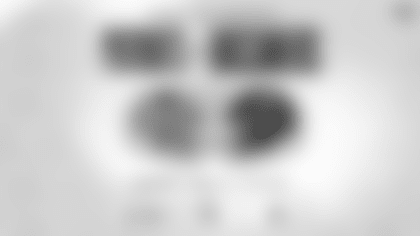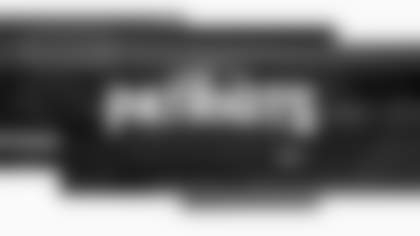The Patriots will face a divisional opponent for a second time in Sunday’s matchup with the Jets at Gillette Stadium.
Although these two teams met already, a lot has changed for both sides since a 24-3 loss to Gang Green on Sept. 19. The Patriots made a quarterback change, with rookie Drake Maye making his first career start against an AFC East foe. New York has also undergone substantial changes after firing former head coach Robert Saleh and acquiring three-time All-Pro Davante Adams, reuniting the former Packer with QB Aaron Rodgers.
Along with adding Adams to Rodgers's arsenal, interim head coach Jeff Ulbrich gave offensive play-calling duties to passing game coordinator Todd Downing. With Ulbrich running the defense, Downing took over from OC Nathaniel Hackett to spark a struggling Jets offense. The Jets played the Bills tough in Ulbrich's first game as interim coach, but the coaching overhaul hasn't changed the course of New York's season.
When you look at the Jets roster, one would expect them to be in much better shape than the rebuilding Patriots. Instead, they're only one win ahead of New England at 2-5, which is surprising given that they have a future Hall of Fame quarterback, plenty of weapons with Adams now in the mix, and a defense that has typically been a top-10 unit. The fact that the Jets are underachieving is why Saleh lost his job.
As for the Patriots, the Thursday night game in the Meadowlands was not competitive. The Jets defense overwhelmed New England's offensive line, it was a vintage Rodgers performance in his first game at MetLife Stadium since rupturing his Achilles in his Jets debut, and the talent gap on the two rosters showed in a primetime matchup that was never close.
Since that Thursday night loss, the Patriots have lost four more games in a row. For head coach Jerod Mayo, Sunday's game will be viewed as a test of buy-in. Coach Mayo's comments following last week's loss that his team is playing "soft" right now were notable. As much as we make it about X's and O's in this space, any discussion about Sunday's tilt needs to mention the vibe with the team at 1-6: will they be ready to play?
Without further ado, let's preview both sides of the ball in Sunday's home contest against the Jets:
Patriots Offense vs. Jets Defense: Will the Jets Stick to the Same Formula vs. Drake Maye?
When the Patriots made the quarterback switch, Maye improved the passing game overall, specifically against man-to-man coverage.
With veteran Jacoby Brissett, New England was facing the third-highest rate of both man coverage (38.8%) and single-high safety shells (48.5%). The formula was to force the Pats receivers to uncover against tight man coverage, send pressure at Brissett behind a patchwork offensive line, and use the extra bodies in the box to shut down the Pats run game.
In the first five weeks, the strategy was working for opposing defenses to a tee. Brissett ranked 26th among 32 quarterbacks in expected points added per drop-back vs. man coverage (-0.40), averaging just 4.6 yards per attempt with a 67.5 passer rating. Meanwhile, the Pats were 22nd in rush EPA, with defenses stacking the box (-0.11).
During his first career start in Week 6, Maye threw for 110 yards and two touchdowns against man schemes vs. Houston. However, Maye's numbers were more in line with Brissett's this past week, partially due to WR DeMario Douglas's playing only 17 snaps vs. the Jaguars due to an illness. Without their man-coverage winner in the slot, Maye was just 5-of-11 for 47 yards when the Jags played man.
As we transition into this week's matchup with the Jets, will Ulbrich approach this game like New York's defense did in Week 3? In the first matchup, the Jets played nearly half of their coverage snaps in man (47.8%), with Cover-1 being their most frequent coverage call (10 drop-backs). The Jets also set a Saleh-era high by blitzing Brissett on 40% of his drop-backs, pressuring the Pats former starter 52.2% of the time. Brissett was just 3-of-8 for 32 yards with three sacks vs. man coverage.
To the Jets coaching staff's credit, it was a good game plan New England likely wasn't expecting. Saleh's roots were in the Seattle-3 defense with the 49ers, which is a zone coverage-based scheme that usually uses a four-man rush. The Jets don't typically blitz much because they need to maintain their numbers in their zone structures, but that has changed this season. In 2024, New York is playing the sixth-highest man coverage rate in the NFL (38.2%).
Furthermore, the Jets have become even more man-heavy since firing Saleh. Ulbrich has dialed-up man coverage on 45.9% of the Jets passing plays compared to 35.3% with Saleh. New York's cover zero usage, man coverage without a deep safety to form an all-out blitz, has also jumped considerably from 1.8% to 9.8% over the last two weeks. Based on the film and data, the expectation is that the Jets will come after Maye as they did to Brissett.
To combat the Jets man coverages, OC Alex Van Pelt has the following options. For starters, the Pats did have some positive plays vs. man coverage in Week 3. They also missed on a couple of layups that Maye should hit. New England had moments while running crossers to Pop Douglas, mesh concepts, and a dressed-up "Seattle" concept that produced an open receiver for what should've been a chunk play.
Pittsburgh also put some answers on film against the Jets last week. Above, The Steelers hit the fade on a similar mesh concept and ran a pick-wheel play for explosives against man. The Pats offense is begging for some pick plays. Rubs or picks are great answers vs. man coverage, but the Patriots haven't featured them much despite seeing a high man coverage rate.
One positive development for the Patriots during their six-game losing streak is third-overall pick Drake Maye. Since taking over as the starter, Maye has been a net-positive performer. He improved from his first start to his second, showing great poise and playmaking ability both in and out of structure. Last week, Maye's anticipation and turnover/sack avoidance improved from the previous week. His ability to operate the offense and make plays from the pocket has been very encouraging – that's real quarterbacking, not just running around on the playground.
Now, it would be nice for the running game to supplement the spark Maye has provided in the passing game. With moving parts on the line, the run-blocking has regressed mightily. In Week 7, the Pats generated -2 yards before contact vs. the Jaguars. This Jets defense flows fast from sideline to sideline, so the best thing to do is try to crease them on the interior with trap, wham, and duo schemes aimed at attacking them downhill.
If the Patriots do one thing right the rest of this season, it has to be keeping Maye on an upward trajectory. The rest of the program is taking its lumps in the first year of the Mayo-Wolf era. This organization cannot afford to let the rookie quarterback spiral, too. Maye looks like the real deal, and New England must keep that arrow pointed upward.
Patriots Defense vs. Jets Offense: Correcting Mistakes vs. Rodgers From Week 3 Loss
Moving over to the other side of the ball, the Patriots defense didn't have any answers either for the Jets offense in their last meeting, and now New York has added Adams into the mix.
In Week 3, Rodgers added +18.2 total expected points, his best performance of the season. Although the stats don't necessarily back it up, the Jets have two capable running backs in Breece Hall and rookie Braelon Allen, who can bite off chunks against a Pats run defense that has allowed an average of 185.3 rushing yards over the last three games. On paper, this Jets offense is a scary matchup for New England's defense.
Still, that doesn't mean the Patriots won't try to slow down Rodgers and company. Before we get into the schematic chess match, there are a few evolving trends since Downing took over as the play-caller for the Jets. With Downing, New York's situational run-pass tendencies haven't changed much. On the whole, they're still a heavy passing team in neutral situations.
However, Downing has made some tweaks. Mainly, Rodgers has hardly been under center over the last two games. Since the change at play-caller, Rodgers has only played eight snaps under center or seven percent. In the first five weeks, Rodgers was under center 31.6% of the time. The other schematic tweak is that the Jets are using more motion, motioning over 12 percent more than they were with Hackett.
The Patriots should expect a pass-heavy, shotgun-first offense that wants to give Rodgers quick options to spread the ball around to his playmakers. This season, Rodgers has the second-fastest time to throw in the NFL (2.39s). Despite an offensive line that ranks 25th in pass-blocking win rate, Rodgers has only been under pressure on 25.3% of his drop-backs because of that quick release, the second-lowest pressure rate among qualified quarterbacks.
| Aaron Rodgers, 2024 | Split-Safety Cov. | Single-High Cov. |
|---|---|---|
| EPA/Play | +0.19 | -0.19 |
| Pass Avg. | 7.8 | 5.9 |
| DB Success Rate | 48.2% | 41.8% |
When these two teams met last month, the Patriots committed two errors that played right into Rodgers's hands. First, the Pats played 16 drop-backs, or 40%, in a split-safety shell, which the Jets QB1 has eviscerated all season. Rodgers has added +0.19 EPA per play while averaging 7.8 yards per pass attempt when teams play split-safety coverages. In Week 3, he went 5-for-5 for 56 yards when the Patriots played cover two.
The play design that the Jets spammed with the Patriots in cover two was a high-low concept working off the Tampa-2 linebacker. New York would send an inside receiver, usually a tight end, up the shoot to split the two deep safeties and then fill in underneath with an in-breaking route. Rodgers connected on successful passes, both throwing the seam-splitter and the under.
The other cardinal sin the Patriots committed against Rodgers was allowing him to extend plays outside the pocket. Rodgers threw it back to his MVP days by going 4-of-5 for 71 yards (14.2 average) on extended drop-backs that took over four seconds. He also ran for two first downs on scrambles, killing the Pats defense out of structure.
For example, Rodgers made some back-breaking conversions on third downs when it appeared that the Patriots had good initial coverage. Above, the Pats run a creeper pressure where they blitz two coverage types (Tavai, Peppers) and drop pass-rusher Joshua Uche off the line into the zone distribution. The schemed pressure and pressure holds up at first, but then DT Daniel Ekuale lets Rodgers out to his arm side, and the former MVP converts a third down on the run.
Another issue the Patriots had with playing two-deep safeties is that the Jets ran the ball effectively using their zone-lead schemes without an extra hat in the box. Allen and Hall had eight carries for 48 yards (6.0 YPC) into light boxes compared to 67 rushing yards on 22 carries into neutral (seven defenders) or stacked (eight) boxes in the first matchup.
Although it feels dangerous given the Jets have two matchup problems at receiver, Garrett Wilson and Davante Adams, the data and film strongly encourage teams to play post-safety coverages against Rodgers. The Jets quarterback's splits are nowhere near as good when teams play post-safety zone (cover three, cover one) coverage.
In saying that, if the Pats do play post-safety coverages, they have to look out for Rodgers throwing slants to receivers lined up in the slot and fades to the perimeter. Rodgers throws more go balls (16%) and slants (13.7%) than any other quarterback in the NFL, while he'll also throw quickly into the flats against single off-coverage for easy yards.
We've been clamoring for the Patriots to ditch their six-man zone structures for weeks in favor of more man coverages. Really, since the first Jets game. The Pats don't have the short zone defenders to cover the space necessary, and they've struggled to apply adequate pressure when they bring these exotic blitzes. Instead, we want to see them play man and allow their five-man rush package to go to work. We should also note that the Steelers batted three passes down at the line of scrimmage last week. Rodgers's quick release makes it tough to get to him, so Pittsburgh's D-Line got their hands in passing lanes when it was clear the ball was coming out quickly.
With how successful Rodgers has been while attacking split-safety coverages this season, it is a good week to play to the trends.
Key Matchups
CB Christian Gonzalez vs. Jets WR Garrett Wilson - the Patriots could have Gonzo shadow Adams, but the smarter game plan might be to have Gonzalez take Wilson one-on-one while the coverage tilts toward Adams. In Week 3, Gonzalez covered Wilson 30 times with 16 man coverage matchups, allowing four catches for 25 yards and a touchdown on eight targets. The touchdown came when Gonzo tried to jump an out route but couldn't quite get there in time. Overall, Gonzalez was effective against Wilson, so I'd trust him in that matchup again.
Pats Interior O-Line vs. Jets DT Quinnen Williams - Patriots guards Sidy Sow (right) and Michael Jordan (left) had a tough time in the run game last week. Both struggled with power, and it won't get any easier this week against Williams, who is always a force against New England. Williams had five quarterback pressures with a sack and two stuffs in Week 3. He's a problem.
WR DeMario Douglas vs. Jets CBs Brandin Echols & Isaiah Oliver - The Jets were without starting corners D.J. Reed (groin) and Michael Carter (back) last week. If that's the case again, their replacements can be picked on. Last week, Oliver allowed a 37-yard catch while receivers were 5-for-5 for 81 yards and two touchdowns vs. Echols. The Pats will want to stay away from Sauce Gardner, so getting Pop matched on Echols or Oliver will be key.
DISCLAIMER: The views and thoughts expressed in this article are those of the writer and don't necessarily reflect those of the organization. Read Full Disclaimer












































